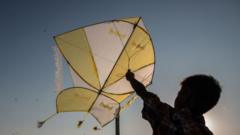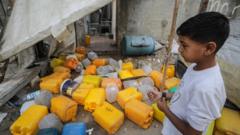**A tug of war between Indonesia's cherished kite-flying tradition and air traffic safety is intensifying, prompting heightened awareness and dialogue about this cultural pastime and its perilous proximity to busy airways.**
**Kite-Flying vs. Aviation Safety: Indonesia's Airspace Challenge**

**Kite-Flying vs. Aviation Safety: Indonesia's Airspace Challenge**
**As children take to the skies with their kites, airport authorities voice serious concerns for aviation safety.**
In a picturesque paddy field just two kilometers from Jakarta's bustling Soekarno-Hatta International Airport, children can be seen gleefully darting across the open expanse, their kites soaring high as jet engines growl overhead. With foam rubber in one hand and strings in the other, they maintain a watchful eye on the skies and below for airport officials who might confiscate their lively additions to the summer scene. Seven-year-old Sean recounts past encounters with officials, once content to flee but now facing the scolding head-on - a testament to the children’s growing bravery.
Kite-flying in Indonesia, especially during school holidays, serves as a cultural touchstone for communities. However, with increasing incidents of kites allegedly posing hazards to aircraft, authorities have expressed unease regarding their safety implications. In the early days of July, for instance, kites led to 21 flight disruptions at Soekarno-Hatta International Airport, forcing planes to divert or abandon landings due to risky encounters.
According to Putu Eka Cahyadi, the airport authority head, kites represent "moving obstacles" for planes, raising serious safety concerns that cannot be overlooked. On their part, authorities are keenly aware that previous incidents significantly heightened attention towards kite safety. Just last July, a helicopter in Bali crashed after its rotor got entangled in kite strings, an occurrence that injured five people. A similar mishap in 2020 revealed kite debris wedged in a plane's engine upon arrival, raising alarms about the looming risks above the runway.
Despite ongoing warnings and educational initiatives encouraging safer outdoor activities, kite-flying remains resilient in Indonesian culture. Colorful, traditionally crafted kites have been a part of the fabric of local community life for generations—flown in harvest celebrations and even as an offering during spiritual ceremonies. Expert Asep Irawan from the Indonesia Kite Museum emphasizes that while kite culture should be preserved, awareness around its dangers must grow, particularly among enthusiastic youth who may not fully comprehend the risks linked to their flyings.
With legal repercussions not uncommon—violations can lead to fines exceeding $61,000 or jail time—the appeal of kite-flying remains hard for many to resist, according to local teenager Rasha, a two-time champion in community kite contests. He notes a stark decline in available open spaces in Jakarta due to rampant urbanization, which leaves children like him with scant options for their beloved pastime.
Tragically, kite-related incidents are not confined to aviation; they have claimed lives on the ground too. Last year, an eight-year-old child lost his life after running onto a toll road while chasing a kite. Furthermore, an incident in 2020 led to blackouts across thousands of homes after a fallen kite disrupted a power station in Bali.
While the incessant laughter and cheers of kite-flying children signal the joy of summer in Indonesia, that joy is now intertwined with the serious responsibility of ensuring safe skies—an endeavor that faces many challenges amid advancing technology and urban pressures.

















